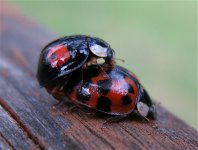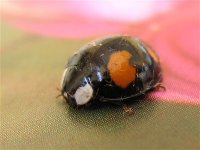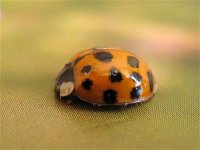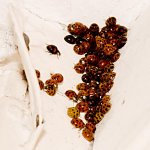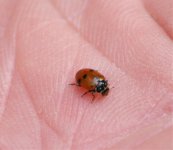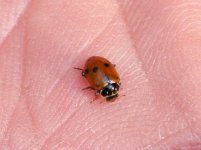-
Welcome to BirdForum, the internet's largest birding community with thousands of members from all over the world. The forums are dedicated to wild birds, birding, binoculars and equipment and all that goes with it.
Please register for an account to take part in the discussions in the forum, post your pictures in the gallery and more.
You are using an out of date browser. It may not display this or other websites correctly.
You should upgrade or use an alternative browser.
You should upgrade or use an alternative browser.
The Ladybird thread (2 Viewers)
- Thread starter Andy Bright
- Start date
More options
Who Replied?paul mabbott
Urban space man
Yes, brilliant sequence of birth, growth and cannibalism!
Like your other pictures too but I'm surprised that, with the asparagus and lily beetles amonst other 'pests', that you manage to grow anything in your garden!
Cheers, Paul
Like your other pictures too but I'm surprised that, with the asparagus and lily beetles amonst other 'pests', that you manage to grow anything in your garden!
Cheers, Paul
Hi, just joined this site yesterday and found out this thread. Very interesting read. :t:
I've made photographic diaries of ladybird births over the last 2 years. Please come and have a look. You may find them interesting.
Ladybird Diary.
You can also find lots of ladybird images in my Insects Gallery.
redeyedvideo
It's like water off a duck's back!
Harlequin Ladybirds
I saw many of these in my neice's garden at Great Yeldham, Essex yesterday & I was wondering if I should have gone against my nature & advised her to eradicate them. There's no davice on the survey site, does anyone have an opinion?
Dave J
I saw many of these in my neice's garden at Great Yeldham, Essex yesterday & I was wondering if I should have gone against my nature & advised her to eradicate them. There's no davice on the survey site, does anyone have an opinion?
Dave J
Attachments
I saw many of these in my neice's garden at Great Yeldham, Essex yesterday & I was wondering if I should have gone against my nature & advised her to eradicate them. There's no davice on the survey site, does anyone have an opinion?
Dave J
Frankly given how abundant these can be now, I don't think eradicating a few will have any real impact, so may as will leave them be! Certainly I'm seeing far fewer at the moment compared with the last couple of years, but ladybird + many other insect numbers have been down with the weird season we've had.
redeyedvideo
It's like water off a duck's back!
Frankly given how abundant these can be now, I don't think eradicating a few will have any real impact, so may as will leave them be!
Thanks, pretty much what I thought. They were doing a fairly good job of eating each other so I'll leave them to it.
Dave J
Mis
Well-known member
The invasion of the harlequins began yesterday. I thought I wouldn't have any trouble this year because I'd seen very few all summer but they are beginning to squeeze into gaps round the window frames and in the corners of the windows. I'm having to go round the house gathering them up before they get a chance to hide away. It's quite warm and sunny here today and there are quite a few harlequins flying around. I'll keep a note of numbers. Last year I counted over 3000 in just under two weeks.
Brian Stone
A Stone chatting
Brian Stone
A Stone chatting
I said earlier today that the invasion had started! Here are two pictures taken today of harlequins tucked up in cosy corners. There were large numbers flying around all afternoon.
I've also seen quite a few flying around in warm sun today, the first for a few weeks.
Is this an Adonis Ladybird?
I found it in North Lincolnshire in a mixed woodland and heathland/marshland habitat.
Thanks
Jenny
Sure is one!
Thank you, have never seen one of these before. How common are they? (It was in North Lincolnshire)
Thanks.
Paul will probably tell you about their distribution, but it's not that common + they often seem to be associated with waste/disturbed sites + populations often appear to be transient. I don't see them that often.
paul mabbott
Urban space man
The Adonis' is one of the few larger British ladybirds considered notable (the 5-spot is very localised and the 13-spot is only seen every ten-20 years) - and was classed a 'notable B' species. Is primarily a southern and eastern species which is not seen often but when it is seen may be in hundreds. It tends to appear in one place and then disappear, as Aeshna notes, it likes ruderal vegetation including gardens and, especially, estuarine/riverine mud/sand banks - low flat ones where vegetation grows in the summer. It tends to prefer warm, light, sandy or calcareous soils.
http://www.searchnbn.net/gridMap/gridMap.jsp?allDs=1&srchSpKey=NBNSYS0000008315 (which is inevitably out of date) shows the distribution up to Yorkshire and Lancashire (mainly at the coast and on rivers) and it is undoubtedly moving north with climate change.
http://www.searchnbn.net/gridMap/gridMap.jsp?allDs=1&srchSpKey=NBNSYS0000008315 (which is inevitably out of date) shows the distribution up to Yorkshire and Lancashire (mainly at the coast and on rivers) and it is undoubtedly moving north with climate change.
Paul will probably tell you about their distribution, but it's not that common + they often seem to be associated with waste/disturbed sites + populations often appear to be transient. I don't see them that often.
Thank you, that is all very interesting to know. It is certainly the first time I have seen one of these. I wondered intially if it may be a Harlequin but when I checked pictures on the internet I saw it looked like an Adonis so I'm pleased that ID has been confirmed.
Jenny
Jenny
paul mabbott
Urban space man
Well worth reporting to the national survey because records are few and far between - can be easily done online at : http://www.ladybird-survey.org/
They'll accept a picture or you can quote me
Indeed, to everyone in UK - all records, even of the more "common" species, are welcomed at the survey - they may not be common one syat .... :eek!:
They'll accept a picture or you can quote me
Indeed, to everyone in UK - all records, even of the more "common" species, are welcomed at the survey - they may not be common one syat .... :eek!:
Thank you, that is all very interesting to know. It is certainly the first time I have seen one of these. I wondered intially if it may be a Harlequin but when I checked pictures on the internet I saw it looked like an Adonis so I'm pleased that ID has been confirmed.
Jenny
paul mabbott
Urban space man
'Harlequin ladybird'
This is all rather British and parochial so an update on the European spread of Harmonia axyridis - it has now been found in Oslo, Norway - not surprised at the northward spread since it is found in Siberia. Equally interesting is that it seems to be penetrating deeper into central Europe at higher altitudes - central Germany, Luxembourg, Alsace &c - haven't yet heard of any from the Alps.
It also seems to be more numerous in northern/central France than previously - large numbers in Paris for instance. Although established in France for sveral years, the largest populations have always been in Nederladn and Belgium - possibly released there in large numbers? So the numbers in France now might relate to southward migration ... or French farmers/horticulturalists have started releasing lots of them?
There is a European recording centre - whose url I forget at the moment - may have published it earlier in the thread?
Haven't heard many recent reports from North America .....
This is all rather British and parochial so an update on the European spread of Harmonia axyridis - it has now been found in Oslo, Norway - not surprised at the northward spread since it is found in Siberia. Equally interesting is that it seems to be penetrating deeper into central Europe at higher altitudes - central Germany, Luxembourg, Alsace &c - haven't yet heard of any from the Alps.
It also seems to be more numerous in northern/central France than previously - large numbers in Paris for instance. Although established in France for sveral years, the largest populations have always been in Nederladn and Belgium - possibly released there in large numbers? So the numbers in France now might relate to southward migration ... or French farmers/horticulturalists have started releasing lots of them?
There is a European recording centre - whose url I forget at the moment - may have published it earlier in the thread?
Haven't heard many recent reports from North America .....
Well worth reporting to the national survey because records are few and far between - can be easily done online at : http://www.ladybird-survey.org/
They'll accept a picture or you can quote me
Indeed, to everyone in UK - all records, even of the more "common" species, are welcomed at the survey - they may not be common one syat .... :eek!:
Have just submitted a report form. It didn't ask for a photo or anything but if they get back to me I can send them photos.
Many thanks.
Jenny
Users who are viewing this thread
Total: 3 (members: 0, guests: 3)




